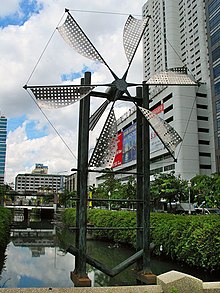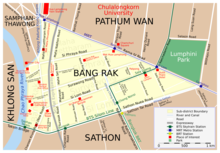Thanon Silom
The Thanon Silom ( ถนน สีลม - literally translated "Windmill Road", in English Silom Road ) is a street in the Bang Rak district of Bangkok , the capital of Thailand . It is an important center for both tourism and finance. This means that the street is regularly clogged with motor vehicles, private cars, buses, delivery vans and mobile food stalls, and not just at rush hour .
history
West of Thanon Charoen Krung (also called New Road) used to be neighborhoods with only a few houses and many vegetable fields and orchards. The first canal road was created, so to speak, as a by-product of a khlong that was excavated as a connection from the Chao Phraya River to the Khlong Hualamphong (today it is filled in, Rama IV Street - Thanon Phra Ram 4 - is above it). The excavated earth was used to raise the level of Silom Road above flood level. This project was funded by the government and completed in 1858. Later roads that were soon laid parallel to the Silom, such as the Thanon Sathon or the Thanon Surawong , were privately financed. The name of the "Silom" comes from the numerous windmills that pumped water from the khlong onto the surrounding vegetable gardens. Similar windmills made of bamboo and cloth are still used today in Samut Sakhon , southeast of Bangkok , to pump salt water from the sea to extract salt in salt pans. A modern steel sculpture, which is supposed to remind of these mills, has been standing a few meters north of Silom Road on the bank of Khlong Chong Nongsi, which runs across Silom Road in the middle of Narativat Rajanakarin Road, since 1998.
Approximately in the middle of Silom Road between Soi 9 and Soi 11 ( Soi : Thai for "side street") until a few years ago there was a very old cemetery with many Christian, but also some Chinese graves. In the 1990s the site was already closed, the cemetery seemed to have been abandoned somehow, but this added to its atmosphere. In 2000, the city council of Bangkok began to tear down the sometimes very picturesque tombs. The demolition work could not be completed until the end of 2004. ( See: web links)
Flea markets
During the lunch break in the area around Soi 10, secretaries from the surrounding offices, shop assistants and bank employees visit them to quickly buy a new pair of shoes or to replace a dirty tie with a brand new one for € 0.10. There are numerous food stalls on the flea markets and the adjacent side streets, which are always very busy at this time.
Shopping centers
- Silom Complex
- Taniya Plaza
Hotels
- Dusit Thani Hotel
- Narai Hotel
- Triple two
- Unico Grande Silom (formerly Tower Inn)
- Holiday Inn Silom
nightlife
Probably the most famous entertainment district of Bangkok is in a side street ( Soi ) : Patpong . The countless go-go bars are hidden today behind several rows of street stalls, the fake Rolex watches on crocodile handbags to mouth painted kitsch paintings all only imaginable tourist trinkets for sale.
Hospitals
- Bangkok Christian Hospital
temple
The Hindu Sri Maha Mariyamman Temple is also called Wat Phra Sri Maha Umathewi ( วัด พระ ศรี มหา อุ มา เทวี ) or Wat Kaek (วัด แขก). Once a year, from the first to the ninth day of the eleventh lunar month, a ceremony is held where the statues of the temple gods are carried by the Hindu community in procession along Silom Road. Some believers have their cheeks or the skin of the upper body pierced with sharp objects, whereby no blood flows, and the believers seem to feel no pain (compare: the Vegetarian Festival on the island of Phuket).
Individual evidence
- Steve Van Beek: Bangkok then and now . AB Publications, Bangkok 2001, ISBN 974-87616-2-2 (English version: ISBN 974-870639-7 )
Web links
- Photo report of the destruction of the cemetery in 2004 (in English)
- Computer-generated view of the Bang Rak district with all high-rise buildings (snapshot from 2003, English names)
- Antique photo from the 1920s of Silom Road (text in English)
Coordinates: 13 ° 43 ′ 29.4 " N , 100 ° 31 ′ 26.4" E


